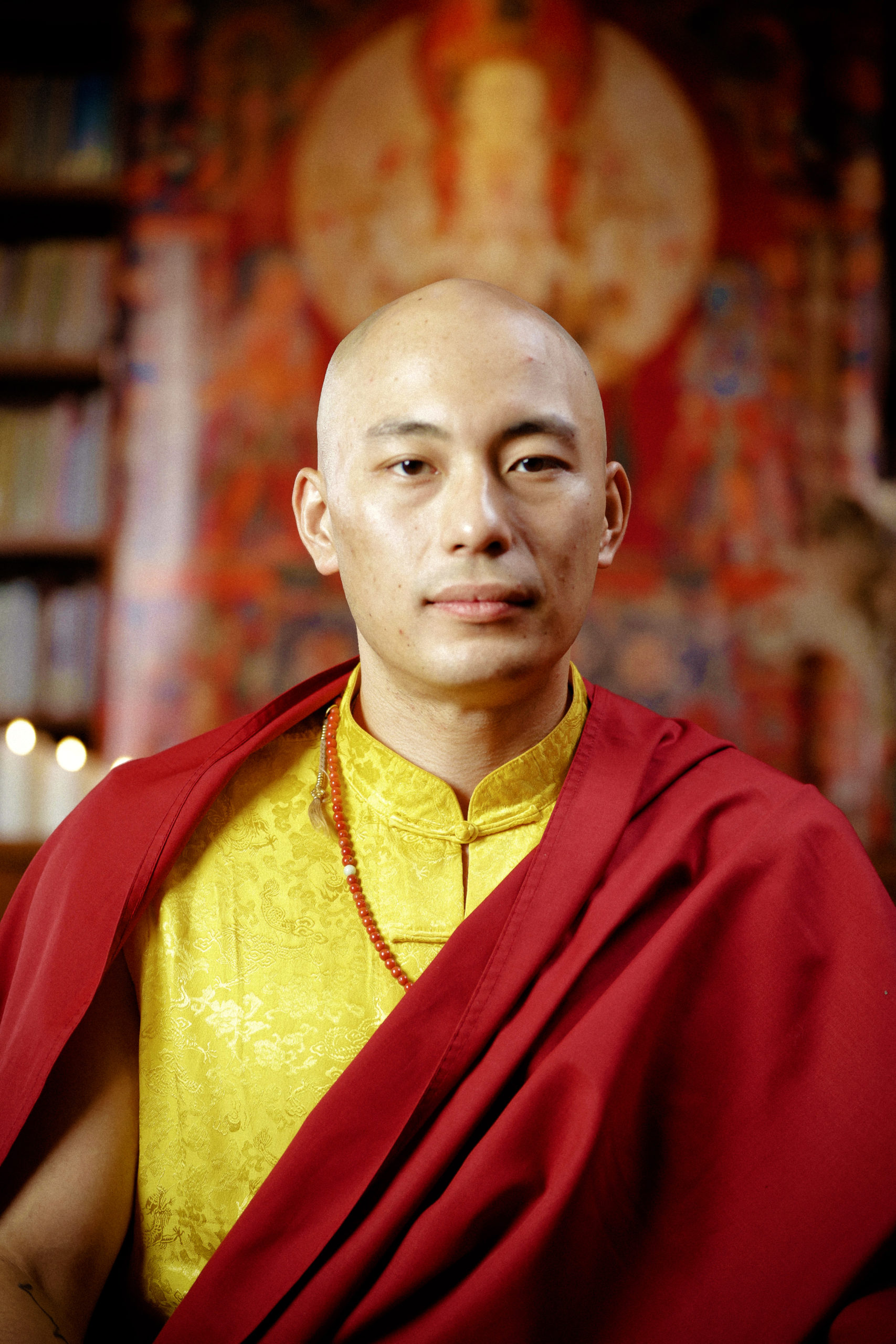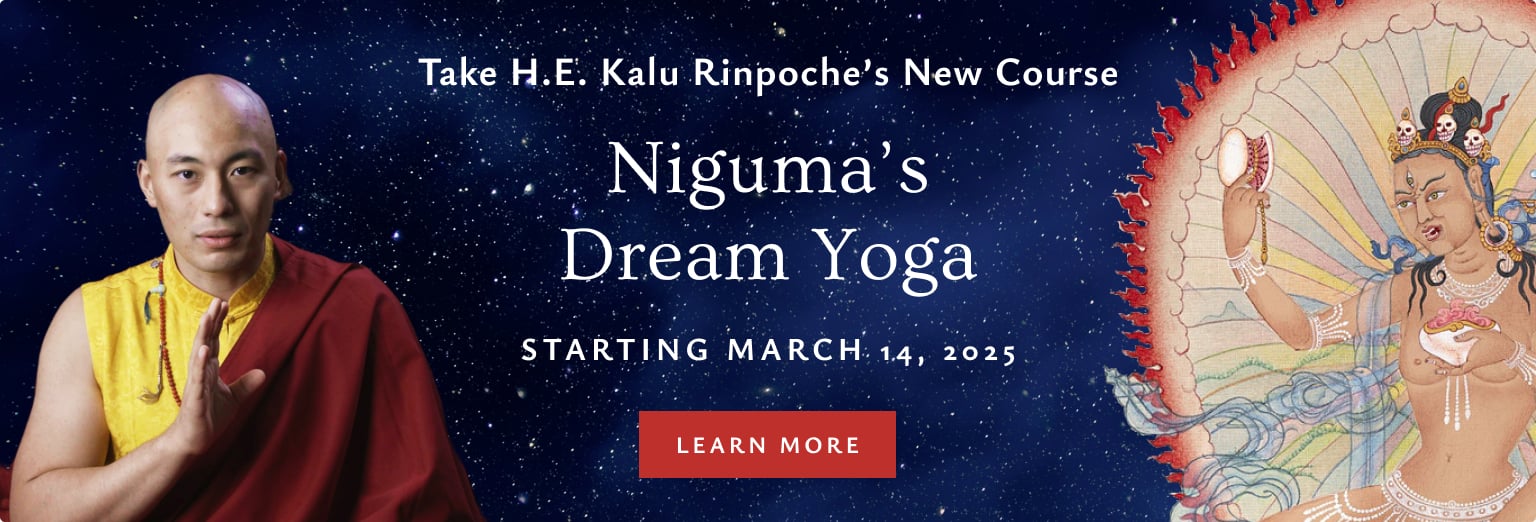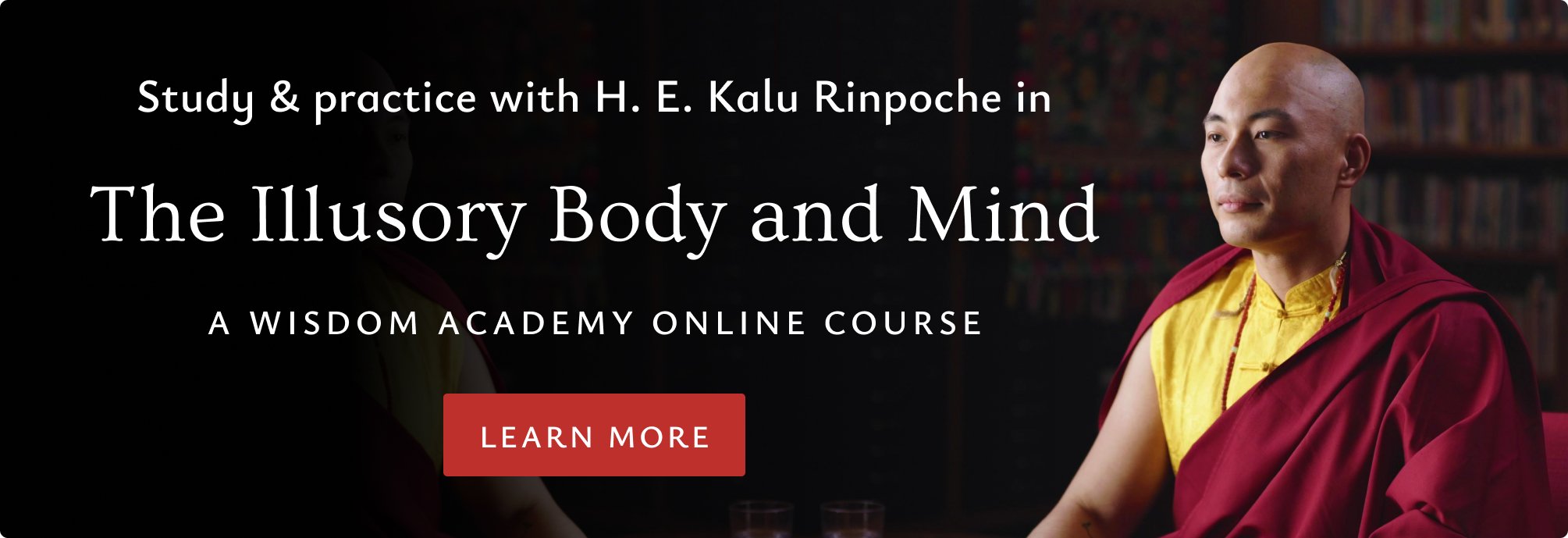About this Course
Focusing on the illusory body and mind, this course features the teachings of the 11th-century dakini Niguma, one of the founders of the Shangpa school of Tibetan Buddhism. The course includes teachings on bardo practice, deity yoga, the nature of mind, practicing with the challenges of everyday life, the illusory body and mind meditation, and more. Rinpoche masterfully brings together his deep knowledge of Dharma and his clear, compassionate understanding of the challenges on the path to liberation.
Lessons
Lesson 1: Overcoming Fixation: Introduction to Vajrayana Practice
His Eminence Kalu Rinpoche begins the course by sharing his personal experiences of retreat and discussing how a Vajrayana practitioner should overcome samsaric fixation and awaken a subtler level of awareness through reliance on a range of daily practices. You’ll learn about how to engage in tong-len (giving-and-taking), deity yoga, and the preliminary practices in the context of purifying negativity and accumulating virtue.
His Eminence Kalu Rinpoche begins the course by sharing his personal experiences of retreat and discussing how a Vajrayana practitioner should overcome samsaric fixation and awaken a subtler level of awareness through reliance on a range of daily practices. You’ll learn about how to engage in tong-len (giving-and-taking), deity yoga, and the preliminary practices in the context of purifying negativity and accumulating virtue.
Lesson 2: Proper Reliance on the Vajra Master
Rinpoche embarks on a wide-ranging exploration of faith in the context of Vajrayana practice, giving particular attention to the relationship with the vajra master. He explains how such a relationship can—in conjunction with continual awareness—ensure that the teachings leave a profound impact on your character. You’ll gain a more thorough understanding of the proper motivation, view, devotion, conduct, and approach with respect to one’s guru.
Rinpoche embarks on a wide-ranging exploration of faith in the context of Vajrayana practice, giving particular attention to the relationship with the vajra master. He explains how such a relationship can—in conjunction with continual awareness—ensure that the teachings leave a profound impact on your character. You’ll gain a more thorough understanding of the proper motivation, view, devotion, conduct, and approach with respect to one’s guru.
Lesson 3: The Path to Recognizing the Nature of Mind
Rinpoche comments on the previous Kalu Rinpoche’s Good Path Traveled by the Fortunate, outlining how to strive toward realizing the nature of mind, from the stage of renunciation of samsaric fixation to that of dwelling naturally in the mind’s clarity and purity. You’ll gain an understanding of the three-stage process of recognizing the nature of mind, maintaining that recognition, and completing one’s realization.
Rinpoche comments on the previous Kalu Rinpoche’s Good Path Traveled by the Fortunate, outlining how to strive toward realizing the nature of mind, from the stage of renunciation of samsaric fixation to that of dwelling naturally in the mind’s clarity and purity. You’ll gain an understanding of the three-stage process of recognizing the nature of mind, maintaining that recognition, and completing one’s realization.
Lesson 4: Physical Postures, Mudras, and Subtle Channels
Rinpoche gives line-by-line commentary on three key meditation manuals attributed to Shangpa Kagyü lineage lamas Niguma, Rahulagupta, and Sukhasiddhi. You’ll learn how to adopt the proper meditation posture, visualize the merit field and subtle bodily channels, form correct hand mudras, and rest in the space-like nature of mind.
Rinpoche gives line-by-line commentary on three key meditation manuals attributed to Shangpa Kagyü lineage lamas Niguma, Rahulagupta, and Sukhasiddhi. You’ll learn how to adopt the proper meditation posture, visualize the merit field and subtle bodily channels, form correct hand mudras, and rest in the space-like nature of mind.
Lesson 5: Blending the Spiritual and Mundane: Song of a Mahāsiddha
Rinpoche reads through and provides thoughtful reflections on “vajra songs” attributed to the famed mahāsiddha Rahulagupta. You’ll receive practical and impactful guidance on retreat and everyday practice as well as greater insight into meditating on the nature of mind.
Rinpoche reads through and provides thoughtful reflections on “vajra songs” attributed to the famed mahāsiddha Rahulagupta. You’ll receive practical and impactful guidance on retreat and everyday practice as well as greater insight into meditating on the nature of mind.
Lesson 6: First Category of Preliminaries in the Illusory Body and Mind Practice
Rinpoche situates the six yogas of Niguma within the broader Five Jewels system, providing line-by-line commentary on Thangtong Gyalpo’s Collection of Essentials to clarify the first category of preliminary practices (i.e., refuge, bodhicitta, and purification). You’ll learn about the deeper meaning of the four empowerments and the finer details of the visualization associated with this stage of the practice.
Rinpoche situates the six yogas of Niguma within the broader Five Jewels system, providing line-by-line commentary on Thangtong Gyalpo’s Collection of Essentials to clarify the first category of preliminary practices (i.e., refuge, bodhicitta, and purification). You’ll learn about the deeper meaning of the four empowerments and the finer details of the visualization associated with this stage of the practice.
Lesson 7: Niguma’s Heart Advice: Second Category of Preliminaries
Commenting on passages from Thangtong Gyalpo and Tāranātha’s works, Rinpoche covers the second category of preliminaries, which comprises the visualization, purification, and ascertainment of signs relating to the “empty AH” practice. He goes on to describe the initial stages of the actual illusory body and mind meditation. You’ll receive clear and essential advice on how to maintain the appropriate view and approach to the practice.
Commenting on passages from Thangtong Gyalpo and Tāranātha’s works, Rinpoche covers the second category of preliminaries, which comprises the visualization, purification, and ascertainment of signs relating to the “empty AH” practice. He goes on to describe the initial stages of the actual illusory body and mind meditation. You’ll receive clear and essential advice on how to maintain the appropriate view and approach to the practice.
Lesson 8: The Illusory Body and Mind Primary Practice Session
Rinpoche follows a concise yet essential text composed by Jamgon Kongtrul Lodroe Thaye on how to practically conduct an entire meditation session on the illusory body and mind. He gives particular attention to foundational topics such as gratitude, diligence, and karma. You’ll refine your understanding of the visualizations and how to pursue these meditations in the context of your daily practice.
Rinpoche follows a concise yet essential text composed by Jamgon Kongtrul Lodroe Thaye on how to practically conduct an entire meditation session on the illusory body and mind. He gives particular attention to foundational topics such as gratitude, diligence, and karma. You’ll refine your understanding of the visualizations and how to pursue these meditations in the context of your daily practice.
Lesson 9: Eight Visualizations in Illusory Body and Mind Practice
Rinpoche focuses on Jamgon Kongtrul’s root stanzas on the six yogas of Niguma that describe how practitioners of each of the three levels of faculties—higher, middling, and lesser—should pursue the preliminary practice and primary practice sessions of illusory body and mind training. You’ll learn how to faultlessly engage in the eight categories of visualization presented.
Rinpoche focuses on Jamgon Kongtrul’s root stanzas on the six yogas of Niguma that describe how practitioners of each of the three levels of faculties—higher, middling, and lesser—should pursue the preliminary practice and primary practice sessions of illusory body and mind training. You’ll learn how to faultlessly engage in the eight categories of visualization presented.
Lesson 10: Essential Instructions on the Bardo Practice
Rinpoche returns to Thangtong Gyalpo’s Collection of Essentials, supplementing with passages from a Jamgon Kongtrul work to provide thorough instructions on how to engage in the bardo or intermediate state practice. He also shares personal experiences with retreat as well as his teacher entering the state of thuk-dam. You’ll discover the importance of dream yoga and learn how to prepare for one of three scenarios awaiting us in the bardo.
Rinpoche returns to Thangtong Gyalpo’s Collection of Essentials, supplementing with passages from a Jamgon Kongtrul work to provide thorough instructions on how to engage in the bardo or intermediate state practice. He also shares personal experiences with retreat as well as his teacher entering the state of thuk-dam. You’ll discover the importance of dream yoga and learn how to prepare for one of three scenarios awaiting us in the bardo.
About the Teacher

His Eminence the 2nd Kalu Rinpoche
His Eminence the 2nd Kalu Rinpoche was born on September 17, 1990 in Darjeeling, India. His father, Lama Gyaltsen, was a nephew of the previous Kalu Rinpoche and had also been his secretary since his youth. The 2nd Kalu Rinpoche was recognized on March 25, 1992 by Tai Situ Rinpoche. His Holiness the Dalai Lama has officially confirmed the recognition.
On February 28, 1993, he was inducted into Samdrub Darjay Chöling (Sonada). His father passed away in 1999 and he asked to live in the monastery of Bokar Rinpoche in order to grow and study under his direction. In 2004, he began the traditional three-year retreat, which he completed in 2008. In 2009, he received from Tai Situ Rinpoche all the transmissions of the Shangpa Lineage. On this occasion, he undertook to confer 108 times the cycle of initiations of the lineage from which he is now holder.
In 2010, Kalu Rinpoche traveled to the West and took charge of the meditation centers created by the first Kalu Rinpoche around the world. In 2014, he returned to Burgundy, in the center of meditation Palden Shangpa La Boulaye, to teach and to resume the tradition of Monlam Shangpa initiated by his predecessor. He has done the same in the United States in 2019.
Each year, Kalu Rinpoche gives initiations and teachings around the world.


